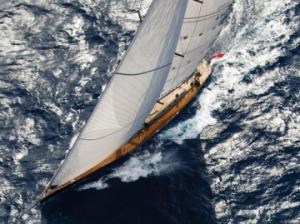About the town
Middle Street offers a special tourist and cultural atmosphere with its street painters in summer, when the whole centre of the town turns into a huge gallery...
RAB, a town and port on the western coast of the island bearing the same name. Situated on an elongated peninsula between the Cove of St. Fumia and the port of Rab, where a compact Mediterranean settlement was built. The town port lies in a protected bay; the outer and inner ports are divided by a breakwater. The depth in the central part of the inner harbour attains between 3 and 5 m; 6-8 m along the eastern embankment of the peninsula, where a 70-m long pier for larger vessels was constructed. The port for smaller vessels has a depth of 4 m. The islet of Tunera, connected by a bank with the coast, protects the outer port from the influence of the open sea. The port is protected by a breakwater to the south-west, along which, on the inner side, larger vessels of the coastal shipping dock. The marina is in the north-eastern part of the town port.
Tourism in the town of Rab has a history of a hundred years. The Komrcar Park in the town, from the end of the 1890s, the public beach and the almost 100-year-old hotel Imperial in the centre bear witness to the long tradition in tourist trade. Except in the town proper, the nearby Kalifronta peninsula, which can be reached by a speedboat or a tourist taxi boat (provided by the local inhabitants), also offers excellent bathing opportunities. Due to the favourable climate and the beautiful, preserved historical scenery, the tourist season commences already in the early spring, and ceases with the late autumn.
Today Rab offers a variety of accommodation facilities (hotels, bungalows, apartments, marina), as well as various sports and recreation opportunities (tennis courts, boccia and bowling alleys, miniature golf, underwater fishing, water skiing). Numerous restaurants offer local specialities (crabs, mussels, fish), while summer terraces and night clubs provide entertainment programs. The luxuriant island vegetation invites for a walk.
Middle Street offers a special tourist and cultural atmosphere with its street painters in summer, when the whole centre of the town turns into a huge gallery, and the Rab Cultural Events in the "Knezev dvor" Gallery represent another important event. The Rab Musical Evenings, organized in the church of the Holy Cross (June to August), offer concerts performed by Croatian and international musicians. The most attractive summer event in Rab is the Rab Tournament (reintroduced in 1995), which used to take place as early as 1364, commemorating the defence of the town by the knights in the past. A special attraction of this picturesque mediaeval ceremony is the ancient crossbow, which is used at the tournaments only by the arbalists from San Marino. The tournament takes place twice a year (9th of May and 27th of July).
The old part of the town was fortified (12th-13th c.). The Prince's Palace (13th c.) stands on the northern side of the Municipium Arba Square, turned during the Gothic (two windows) and Renaissance (double window) periods into a massive three-storey building, to which a two-storey wing (with a beautiful balcony) towards the sea was attached. The inner court of the palace accommodates a collection of stone monuments including finds dating from the Roman period to the Renaissance.
A 26-m high bell tower of the cathedral of a Lombardian type (around 1200), covered with a pyramid (15th c.) rises in the middle of a small square. The church of St. Mary the Great, a three-nave Romanesque basilica with three apses, is opposite the bell tower. It was consecrated by Pope Alexander III in 1177. The ciborium above the main altar of the church was erected in the 11th century. Although reconstructed at the end of the 15thcentury, it represents the only in situ preserved example of the pre-Romanesque altar superstructure on the Croatian coast.
The church of St. Justa (1573-78) is situated in Upper Street (Gornja ulica); its bell tower dates from the 1672. Today the church hosts an sacral art exhibition, including the portable little altar, donated to the town by King Koloman, fragments of the illuminated evangelistary from the 11th century and the silver-plated reliquary for the head of St. Christopher (beginning of the 13th c.); the polyptych by Paolo Veneziano; a Renaissance terra cotta of the Mother of God with Christ from the 15thcentury; several altar paintings from the 16th to the 18th century.
The passage through the tower of St. Christopher (Galjarda) with a guard-house leads to Komrar Park, one of the most beautiful parks on the eastern part of the Adriatic coastline, landscaped in the 1890s, on the total area of 16 hectares, by Juraj Belia (Aleppo pine, Primorje pine and black pine, holm oak, spruce, cypress). The ruins of a Franciscan monastery from 1491 are found at the north-eastern rim of the park, now the town cemetery. The church of St. Francis from 1491, a building in the mixed Gothic and Renaissance style, the tomb of the Spanish painter Juan Boschetus, who died in 1523, is today a graveyard church.

HOT DEALS !
get the best deal
& the best yacht
Home / About Croatia / Adriatic Sea - regions / Adriatic North / Islands / Rab / Towns / Rab / About the town